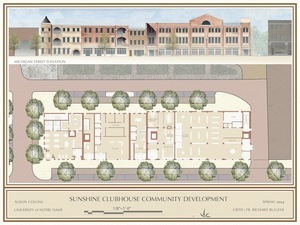Sunshine Clubhouse Community Development: A Case for the Sustainable Design of Clubhouses
- Student
- Alison Collins
- College(s)
- School of Architecture
- Faculty Advisor
- Lucien Steil
- Class Year
- 2014

Clubhouses help people with Serious Mental Illness “access the same worlds of friendship, housing, education, and employment as the rest of society.”
Why is sustainable design important for Clubhouses and cities?
- Climate change is likely to be the greatest destabilizing force politically and socially of the next century (Edwards 7)
- Human-caused climate change is happening and is accelerating; dangerous impacts are becoming evident around the world, and are projected to get worse in the decades to come, possibly much worse (IPCC, 2013). Nearly all climate scientists are convinced of these basic facts… (Maibach)
- Transport accounts for 26% of global CO2 emissions and is one of the few industrial sectors where emissions are still growing (Chapman)
- In the US, buildings account for 40% of raw materials use, 38% of carbon dioxide emissions, 24-50% of energy use and 72% of energy consumption (Green Building 4)
- 7,000 acres of forests, farms, and countryside are lost to sprawl every day (Duany 12)
What can be done?
- Walk or bike to work
- Support sustainable agriculture
- Use energy-efficient appliances
- Use heat, air-conditioning and water less
- Construct more sustainable buildings
But, how?
Smart growth and New Urbanism are counters to suburban sprawl and promote environmental behavior without people thinking about how to be sustainable. Green buildings are designed with sustainable design methods and construction materials.
My architecture thesis, the Sunshine Clubhouse Community Development in South Bend, Indiana shows how sustainable design in architecture and urbanism can improve the triple bottom line of a Clubhouse and the greater South Bend community.
SITE SELECTION
- Site has good proximity to other neighborhoods and nature.
- Is a safe neighborhood
- Has potential for urban agriculture
- Is close to employment opportunities, housing, and entertainment but also development at this location would be strongly supported by surrounding area
TRANSPORTATION
- Located on bus route
- 15 minute walk from Transpo Station
WALKABILITY
- Proposing mixed-use buildings that define street edge
- Ground floor commercial for dynamic interaction with street
- Ground floor of Clubhouse=Clubhouse Thrift Shop
NATURE
- Located Clubhouse on St. Joseph River
- Exterior spaces on upper floors offer access to fresh air and nature views without going to ground floor
- Tree-lined streets, urban parks and connecting the West Bank Trail
IDENTITY
- Clubhouse should not be isolated- so integrated it into a block of mixed-use buildings
- Clubhouse at ground level welcomes community to interact with Clubhouse members
- Large thermal window on third floor gives character and identity
- Relate with the community in any way to eliminate the stigma associated with Serious Mental Illness
GARDENS
- 1/3 of an acre proposed as Unity Garden
- Roof garden to grow food for Clubhouse, while improving air quality
GREEN BUILDING
- Large, operable windows to reduce need for cooling, ventilation, and lighting
- Load bearing masonry wall and interior brick piers for durable building
- Glue-laminated beams because wood is readily renewed and glu-lams require little energy to produce
- Overall, green design saves money long term; creates a healthier, more productive environment; and is best for the planet
To read more about how sustainable design of Clubhouses and towns can contribute to their triple bottom line, see the full report, Sunshine Clubhouse Community Development. (Link to PDF of paper) The end of the report offers explicit guidelines for Clubhouse and cities to design more sustainably.
I am so grateful I was introduced to this project and am simply delighted I was able to meet so many wonderful, dedicated, and hard-working people. South Bend has amazing potential to become an innovative and thriving city by thinking creatively and sustainably to implement change for the long term, by influencing behavioral change, and by taking action in the short term. In short, I am excited to see what the future holds for the city.
Works Cited
Chapman, Lee. "Transport and Climate Change: A Review." Journal of Transport Geography 15.5 (2007)Print.
"Clubhouse International Mission." Clubhouse International.Web.
Duany, Andres, Elizabeth Plater-Zyberk, and Jeff Speck. Suburban Nation : The Rise of Sprawl and the Decline of the American Dream. New York : North Point Press, 2000. Print.
Edwards, Brian, and Emanuele Naboni. Green Buildings Pay : Design, Productivity and Ecology. London : Routledge, 2013. Print.
Green Building and LEED Core Concepts Guide. 2nd ed. Washington, DC: U.S. Green Building Council, 2011. Print.
Maibach, Edward, Teresa Myers, and Anthony Leiserowitz. "Climate Scientists Need to Set the Record Straight: There is a Scientific Consensus that Human-Caused Climate Change is Happening." Earth's Future (2014): - 2013EF000226. Print.
Stewart, Sara. “Mission Statement.” Unity Gardens. N.p., n.d. Web. 24 Apr. 2014